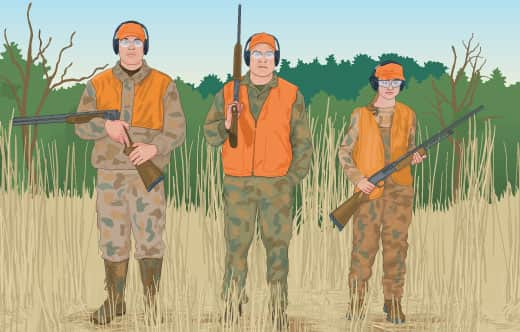Photo Taking Tips that will Help Show Hunting is Safe
Tammy Sapp 09.27.11

When it comes to taking good photographs, the experts often issue advice such as get close to the subject and follow the rule of thirds for composition. Those are great suggestions that can result in first-rate images, especially when combined with tips to ensure you’re portraying hunting as safe.
Many people hold the mistaken belief that hunting is unsafe. As hunters, we can’t emphasize enough that hunting is a safe activity the whole family can enjoy. With so many photos finding their way to Facebook, Flickr and other websites as well as magazines and newspapers, it’s important to take stock of what’s in the viewfinder.
I interviewed two experts from the North Carolina Wildlife Resources Commission: Travis Casper, state assistant hunter education coordinator, and Geoff Cantrell, public information officer. They provided the following advice on how your photos can send the right message, whether you’re a pro or an amateur photographer.
- If you are recreating a hunting scene, make sure the hunter’s finger is outside of the trigger guard, unless his or her cheek is on the stock and the photo is supposed to show the moment before the shot. If the hunter’s cheek is not on the stock, then the finger should NOT be on the trigger.
- If you’re photographing hunters or shooters sighting in their rifles or patterning their shotguns, make sure they are wearing eye and ear protection.
- Make sure muzzles are pointed in a safe direction, especially in group photos. The two-dimensional aspect of still photography flattens images so even though a muzzle may have been pointed in safe direction, it can look dangerous in a photo. Remember, perception is reality so take extra care to make sure muzzle direction is safe, even when reality is compressed into two dimensions.
- If you’re capturing a photo of hunters posed with their trophies, make sure firearms are unloaded and actions are open. During the photo shoot, always treat firearms as if they are loaded.
- If you’re photographing hunters in a tree stand, make sure they are wearing a fall-arrest system and attach it in the manner and method described by the manufacturer. Single-strap belts and chest harnesses are not safe and should not be used.
- Know the hunting regulations in your area to ensure your photos reflect legal behavior. For example, if blaze orange is required for the area, species and season you are hunting, make sure your subject is wearing it. That will serve as a great reminder for others who see your photos.
- If you’re taking photos at a shooting range, whether for a class or a tournament, make sure you listen to and abide by the range master’s directions. Having a camera does not give you license to roam freely at the range.
- When capturing the action of an upland bird hunt, steer clear of setting up so a rising bird will be between the camera and the muzzle. Even if it’s a controlled situation where the hunter’s firearm is unloaded, having a muzzle pointed at the photographer sends the wrong message.
- If you’re a pro who is lining up an important photo shoot, call your state wildlife agency and request a subject matter expert. The agency may be able to connect you with a hunter education volunteer instructor who can be at your shoot to make sure your photos show safe conduct.
“If a picture is worth a thousand words, let’s make sure we’re communicating the right message,” Cantrell said. “At our agency we go through a stringent review process to make sure the photos and video we use show safe hunting practices.”
To help the media, the North Carolina Wildlife Resources Commission hosts field days. At these events, safe hunting and shooting scenarios are set up, allowing shutterbugs to capture images that demonstrate safe behavior.
Casper and Cantrell also suggested that photographers take a hunter safety course. You can receive a quality education at your convenience by taking an online hunter safety course at www.hunter-ed.com or www.bowhunter-ed.com. The training offered at these sites is approved by the state agencies responsible for hunter education.
Studying at www.hunter-ed.com and www.bowhunter-ed.com is free. Those who must be certified before they can buy a hunting license pay a one-time fee, which is due only if they pass the test. Students can take the test as many times as they need to pass it. Online hunter safety and bowhunting education courses are available in participating states, so visit www.hunter-ed.com or www.bowhunter-ed.com to take a course specific to your state.
About Kalkomey
Kalkomey Enterprises Inc., parent company of hunter-ed.com and bowhunter-ed.com, is the official provider of recreational safety education products for all 50 states. Our print and Internet safety courses have been providing official safety certification since 1995. We provide safety courses in boating, hunting, bowhunting, and off-road vehicle (ORV) and snowmobile operation. For more information, visit http://www.kalkomey.com/.
About the North Carolina Wildlife Resources Commission
Since 1947, the North Carolina Wildlife Resources Commission has been dedicated to the conservation and sustainability of the state’s fish and wildlife resources through research, scientific management, wise use, and public input. The Commission is the state regulatory agency responsible for the enforcement of fishing, hunting, trapping and boating laws and provides programs and opportunities for wildlife-related educational, recreational and sporting activities. To learn more, visit http://www.ncwildlife.org/.

